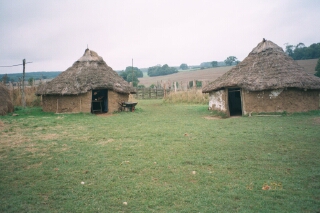
MY TRIP TO LONDON
By: Dixie Hughes
Okay, so everybody takes neat trips sometimes - and rather than boring everyone with the story of my latest big trip, I'm putting it on the web (with Dad's help). This way you don't have to listen to the whole thing; you can just click off when you're bored. And I get to tell everyone how neat it was - even if you don't listen. Winners!
First of all, this was an Elderhostel trip, which means we signed up to learn something, besides going to a neat place (London!). The class was originally listed as "Roman & Medieval Britain" but our instructor announced the first night that we were including "Prehistory" because of the effect it had had on Roman Britain (and also because that's part of his interest). Makes sense to me - besides it was fascinating.
There is very little information about the prehistory of Britain because the Celts and Druids didn't have a written language - the Druids memorized everything that was to be handed down/remembered. They believed that books "ruined the mind" and their Druid leaders had to train for 20 years. Obviously, as they died out, it all disappeared - thus most archaeological information is based on the post holes, stone work, pottery, etc. from their round houses, fence lines, hill forts, etc. A group of environmentalists/scientists/kooks are conducting an "Open Air Laboratory for Archeology, living in an area near Chichester (called Little Buster Ancient Farm) trying to show how it was really done 2000 or 3000 years ago. That means no electricity, no running water, living in thatched roof huts, cooking on central fireplaces, storing grain in pits, making fences of woven hazel saplings, and animal pens with wattle walls. They are showing that the Celts could have lived fairly comfortably - or at least survived - under the conditions. It's a fascinating experiment, although they say it's not much fun in February.

The Celts lived in crude huts. These are replicas of an ongoing experiment to learn how it was to live like a Celt in 1000 B.C.

The thatched roofs had to be at exactly the right pitch to defy gravity and to keep from blowing away or rotting from soaked in rain.
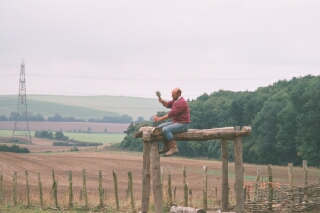
Making an elevated storage shed the way the Celts did - with wooden pegs and a homemade mallet.
The Celts - which is actually a language similarity, rather than a racial or ethnic distinction - originally covered most of northern Europe and bodies buried in Celtic plaid have been found as far away as China. (The Irish, Welsh, Scots, etc. are the only areas still with Celtic influence because those areas were not overrun later by Saxons, Normans, Vikings, etc.) Celt warriors were described (by the Romans) as tall, over-emotional, plaid garbed, fierce fighters with painted faces. They showed honor to their chiefs or bravest warriors by awarding Torcs - wrapped wire of silver/gold/copper which they wore around their necks. Thus the Celt propensity to cut off heads of their enemies (to get their torcs). The archaeologists have found several places - one in the Thames - where many skulls are deposited, thought to be a sacrificial area.
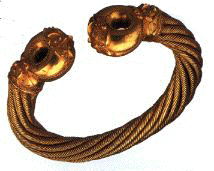
The Great Torc, from Snettisham, Norfolk, 1st Century BC. A characteristic Celtic ornament, the Torc is a heavy neck-ring made of twisted metal. This fine example is made of eight gold strands twisted together, each strand comprising eight gold wires. The ends are secured in elaborately decorated cast gold terminals. (From the British Museum Collection)
The Roman Empire, which gradually extended through what is now France and Germany, arrived in England in 54-55 B.C. with the arrival of Julius Ceasar (who didn't stay long). They found the area divided between many local Celtic tribes who lived in a state of semi-constant warfare. The Romans left and didn't come back until about 40 A.D. with the area officially conquered by 50 A.D. when they established the town of "Londinium" at the first point where the Thames River was easily fordable. Most of their other towns were established where the old Hill Forts had been. The Roman military might - which was very effective for its time - established the area for trading. Celts lived in scattered areas - they had previously had no real use for towns, and the enforced peace (for almost 300 years) was quite welcome to many of the natives.
The Romans conquered an area militarily, and then adopted the local aristocracy - supporting them as long as they paid tribute, and training their children in Rome. Thus their reign adopted many of the local customs, religious beliefs, etc. that furthered the good relations. ("You worship my gods, I'll worship yours" - which is why the early Christians and Jews had so much difficulty because of their refusal to accept other gods.) The aristocracy gradually became very Romanized - over several hundred years when they had mostly all been educated in Rome.
In our field trips around London - to Chichester (Fishbourne Villa), St.Albans (Verulamium Roman Theater), Canterbury (Lullinstone Roman Villa) and to Bath (Roman bath) - plus our walking trip around Roman London - we saw lots of "ruins" dating back almost 2000 years. (No, we didn't get to go to Stonehenge - I really wanted to - which is said to date to 3100 B.C.) And we learned that the Romans who came to Britain lived quite well with their multi roomed houses heated mosaic floors, baths, and their entertainment centers. However, 95% of the people continued to live in the circular huts and farm areas as they had for centuries before the Romans.

Excavated ruins reveal that the upper class Romans lived in houses planned for safety and luxury

Heated Mosiac floors for the Romans, dirt floors for the Celts.

Baths

Arena - Entertainment Center
Of course, in 410 A.D. when the Romans acknowledged their inability to defend their British friends - gave them permission to raise their own armies - the minor chiefs again reverted to constant squabbles and conquests of each other and the peace of Roman rule elapsed.
Enough of ancient history (are you asleep yet?) while we were near these other towns we went to visit the fantastic cathedrals and abbeys that were erected (usually by tearing down the Roman walls and buildings for the stones) during medieval times.
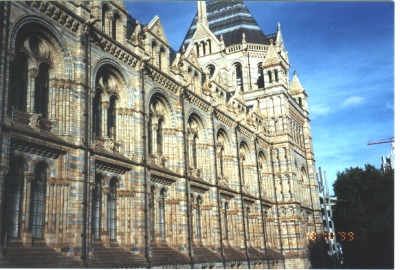
(St Albans Cathedral (famous Rose window not visible in this picture.)

Huge Abbey in the town of Bath
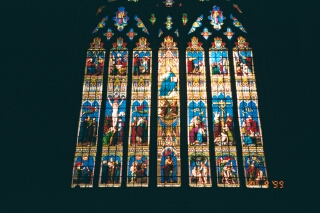
Some of the stained glass windows are so fantastic they take your breath away or maybe that's because of the crick in your neck from looking so far up to see them.
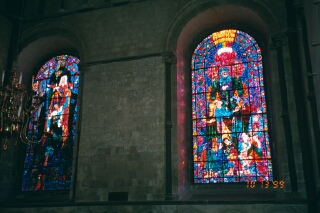
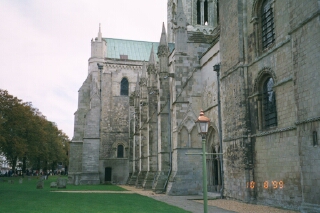
Chichester Cathedral
They are huge buildings with 'flying buttresses' that were used to support such tall walls. Amazing what they could accomplish with so little mechanization.
Of course, constant history can wear off so we took some time to see the sights in London —
the Tower, Trafalgar Square, Tower Bridge, Museum of Natural History and the new Millenium Wheel which will be a huge ferris wheel open for the new millenium.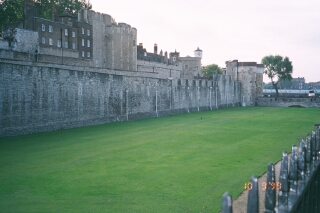
London Tower - The moat is now a lawn.
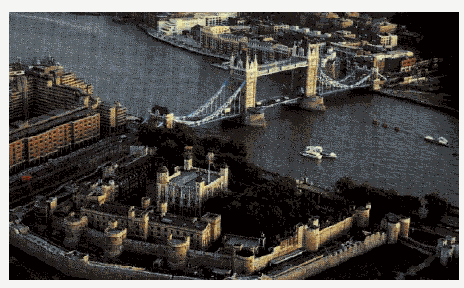
London Tower (actually 13 of them) & Tower Bridge

Famous Lions at Trafalgar Square

What used to be the Royal stables (Mews) became Trafalger Square commemorating the famous victory of Admiral Nelson at the battle of Trafalger in 1805. Nelson's statute is at the top of the tall column.
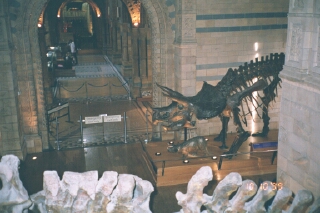
The Museum of Natural History has a fantastic dinosaur display.

Museum of Natural History
I now have a whole list of things I want to see on my next trip over there.
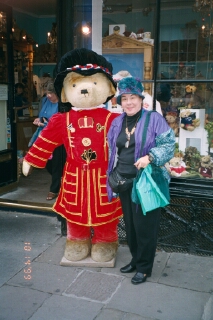
We didn't spend all our time studying history, here I am standing besides a "Beefeater" teddy bear.
On the 17th the Elderhostel class ended and my friend and I went to Paris. That was also an interesting experience — but I’m not eager to go back. They aren’t just rude to Americans — they’re even rude to each other. They had no English guides left in the Louvre — so we saw lots of neat stuff but didn’t know what it was. We had to move through Versailles in cattle chute conditions — no crowd handling abilities at all. So other than a lot of huge buildings and naked statues we didn’t see too much of interest. Not to mention the gypsy kids in the subway. I’m glad I went — and glad to be home, of course.
Return to Dixie's Tour Menu